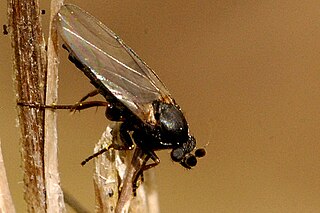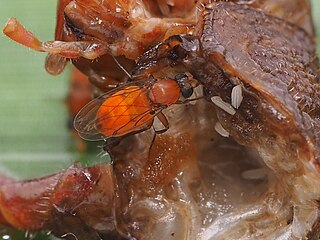
The Phoridae are a family of small, hump-backed flies resembling fruit flies. Phorid flies can often be identified by their escape habit of running rapidly across a surface rather than taking flight. This behaviour is a source of one of their alternate names, scuttle fly. Another vernacular name, coffin fly, refers to Conicera tibialis. About 4,000 species are known in 230 genera. The most well-known species is cosmopolitan Megaselia scalaris. At 0.4 mm in length, the world's smallest fly is the phorid Euryplatea nanaknihali.

The Metopininae are a subfamily of flies in the family Phoridae.

Anevrina is a genus of phorid flies circumscribed by the Italian naturalist Paolo Lioy in 1864.
Megaselia globipyga is a species of scuttle flies.
Phalacrotophora longifrons is a species of scuttle flies.
Megaselia rufipes, the coffin fly, is a species of scuttle flies.
Lecanocerus is a genus of scuttle flies. There is at least one described species in Lecanocerus, L. compressiceps.

Megaselia aurea is a species of scuttle flies.
Puliciphora borinquenensis is a species of scuttle flies.

Puliciphora is a genus of scuttle flies. There are at least 110 described species in Puliciphora.
Rivellia coquilletti is a species of signal flies.

The Metopininae is a tribe of flies in the family Phoridae.
Acontistoptera is a genus of flies in the family Phoridae.
Chonocephalus is a genus of flies in the family Phoridae.
Cremersia is a genus of flies in the family Phoridae.
Diocophora is a genus of flies in the family Phoridae.
Metopina is a genus of flies in the family Phoridae.
Rhyncophoromyia is a genus of flies in the family Phoridae.




